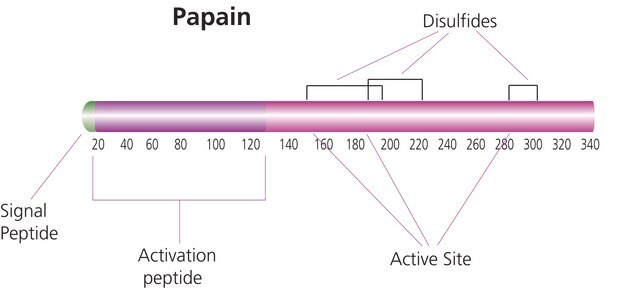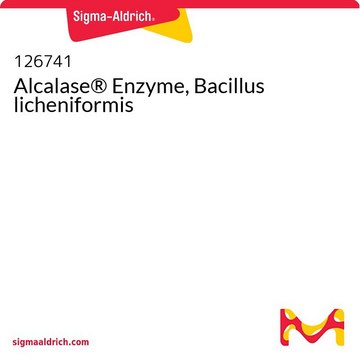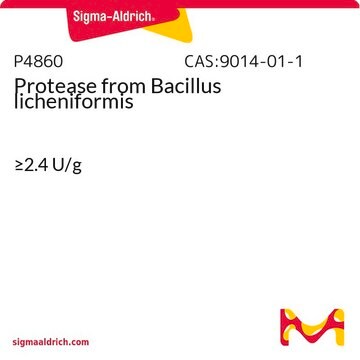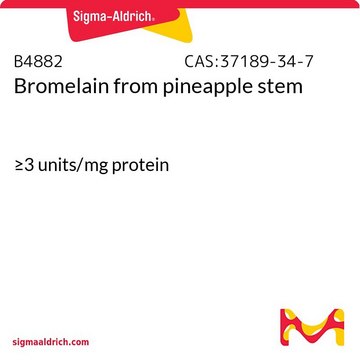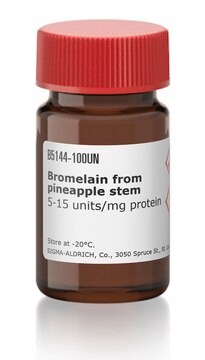Wszystkie zdjęcia(1)
Kluczowe dokumenty
76216
Papain from Carica papaya
solution, light brown, ≥10 U/mg protein (~25 mg/ml)
Zaloguj sięWyświetlanie cen organizacyjnych i kontraktowych
About This Item
Polecane produkty
pochodzenie biologiczne
papaya
Formularz
solution
aktywność właściwa
≥10 U/mg protein (~25 mg/ml)
masa cząsteczkowa
Mr ~23000
metody
cell culture | mammalian: suitable
single cell analysis: suitable
kolor
light brown
temp. przechowywania
2-8°C
Szukasz podobnych produktów? Odwiedź Przewodnik dotyczący porównywania produktów
Opis ogólny
Papain is a proteolytic enzyme and is naturally occurring in papaya (Carica papaya L.). It is obtained from the latex of cut unripe papaya. Papain belongs to the cysteine proteinase family. It is a globular, single-chain protein composed of four disulfide bridges and catalytically essential residues. Papain consists of an all α-domain and anti-parallel β-sheet domain.
Zastosowanie
Papain from Carica papaya has been used:
- in the enzymatic dissociation of rat cortices to extract astrocytes for cell culture
- to study its effects on Alpaca seminal plasma viscosity and sperm function
- to study its effects on the yield and cryo-survival of Rhinoceros spermatozoa
Papain is used as a meat tenderizer. It′s also used to break up tissue in the preparation of primary cell cultures.
Działania biochem./fizjol.
Papain is a cysteine protease that cleaves peptide bonds and is known to cleave the Fc portion of antibodies.
Papain plays an important role in many biological processes in many living organisms. It exhibits proteolytic activity against proteins, amino-acid esters and amide links, and short-chain peptides. Papain preferentially cleaves the peptide bonds of basic amino acids such as arginine, phenylalanine, and lysine. It has a wide range of applications in drug discovery, pharmaceutical, food, baking, and dairy industries.
Definicja jednostki
1 U corresponds to the amount of enzyme which hydrolyzes 1 μmol N-benzoyl-L-arginine ethyl ester (BAEE, Cat. No. 12880) per minute at pH 6.2 and 25°C
Ta strona może zawierać tekst przetłumaczony maszynowo.
Hasło ostrzegawcze
Danger
Zwroty wskazujące rodzaj zagrożenia
Zwroty wskazujące środki ostrożności
Klasyfikacja zagrożeń
Eye Irrit. 2 - Resp. Sens. 1 - Skin Irrit. 2 - STOT SE 3
Organy docelowe
Respiratory system
Kod klasy składowania
11 - Combustible Solids
Klasa zagrożenia wodnego (WGK)
WGK 1
Temperatura zapłonu (°F)
Not applicable
Temperatura zapłonu (°C)
Not applicable
Środki ochrony indywidualnej
dust mask type N95 (US), Eyeshields, Faceshields, Gloves
Wybierz jedną z najnowszych wersji:
Masz już ten produkt?
Dokumenty związane z niedawno zakupionymi produktami zostały zamieszczone w Bibliotece dokumentów.
Klienci oglądali również te produkty
Immobilization of papain: A review
Veymar G, et al.
International Journal of Biological Macromolecules, 188, 94-113 (2021)
José M Laparra et al.
Journal of food science, 74(6), H168-H173 (2009-09-03)
This study aims to understand the enhancing effect of glycosaminoglycans (GAGs), such as chondroitin/dermatan structures, on Fe uptake to Caco-2 cells. High-sulfated GAGs were selectively purified from cooked haddock. An in vitro digestion/Caco-2 cell culture model was used to evaluate
The effect of glycosaminoglycan enzymes and proteases on the viscosity of alpaca seminal plasma and sperm function
Kershaw CM, et al.
Animal Reproduction Science, 138(1-2), 261-267 (2013)
Extraction of Near-Field Fluorescence from Composite Signals to Provide High Resolution Images of Glial Cells
Robert T D, et al.
Biophysical Journal, 80(5), 2477-2482 (2001)
José Moisés Laparra et al.
Journal of agricultural and food chemistry, 56(21), 10346-10351 (2008-10-15)
This study continues previous research to confirm that glycosaminoglycans (GAGs) exert a positive effect on promoting iron uptake by Caco-2 cells. Cooked haddock was digested with papain, and GAGs were further purified on the basis of their sulfur content. Reverse
Nasz zespół naukowców ma doświadczenie we wszystkich obszarach badań, w tym w naukach przyrodniczych, materiałoznawstwie, syntezie chemicznej, chromatografii, analityce i wielu innych dziedzinach.
Skontaktuj się z zespołem ds. pomocy technicznej
